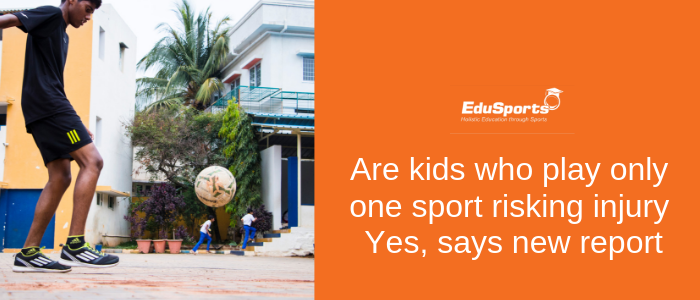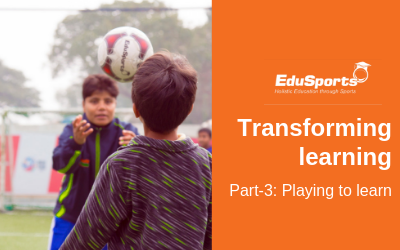“To succeed is to have failed” – learning from failures

Are kids who play only one sport risking injury Yes, says new report
The American Academy of Pediatrics published https://pediatrics.aappublications.org/content/138/3/e20162148. One of the things it found was the danger of kids specializing in one sport, instead of playing several. It recommends that kids not specialize in one particular sport until age 15 or 16.
One of the biggest dangers of specializing early is overuse injuries. It’s estimated that as many as 46 percent to 50 percent of all athletic injuries are due to overuse, but that’s a hard thing to estimate because often sports injuries are not categorized.

Dr. Matthew Ellington is a pediatricorthopedic surgeon at Dell Children’s Medical Center of Central Texas, which was just ranked on of the top 50 hospitals for pediatricorthopedic surgery.
Dr. Matthew Ellington, a pediatricorthopedic surgeon at Dell Children’s Medical Center of Central Texas, says most of his patients are doing just one sport. And it might surprise you which athletes he sees the most. It’s not football, soccer or baseball. It’s dancing, gymnastics and cheerleading. The reason? Those athletes are practicing 15 hours a week and they might only get one day off. “It’s a lot of stress with no rest,” he says.
In dancing and cheerleading, it’s knee injuries. Gymnastics, it’s wrists. We’ve actually written about girls and knee injuries before. That study found that girls were 2.5 to 6.2 times more likely to have an anterior cruciate ligament injury than boys. Some of it is physiological differences in the way boys’ and girls’ bodies are made, but a big factor is the number of hours that are being dedicated to that sport.
Ellington does see plenty of boys as well as non dancers, cheerleaders and gymnasts.
In baseball players, it’s elbows. In basketball, soccer and volleyball players, it’s knees. He doesn’t see as many football players with these types of injuries, he says, mainly because football is one season. However, as kids have started to play flag football in the spring, he is seeing some.
A lot of the injuries are happening during puberty when the skeleton is growing faster than the muscles and ligaments an catch up, Ellington says. Their bodies were meant to have a variety of activities and not endure the same moves over and over again. Remember when kids just went out and played?
The recommendation is that kids get at least three months a year where they are not participating in the one sport. Those three months don’t have to happen all at once, but can be three months on, one month off.
Ellington also recommends at least two to three days off a week, except for stretching. He’d like to kids to do that twice a day.
When kids do have an injury, they have to let their bodies rest and not try to push their way back onto the field or gym floor. And parents have to listen to the doctor and let their child rest.
Parents also need to act when their kids are in pain and not let them “shake it off.” They can also attend practices and make sure that kids are doing stretching and strength training and not just hard-pounding exercise. And, of course, they can make sure that kids are involved in a variety of sports and take time off.
The American Academy of Pediatrics recommends that doctors use these talking points based on the report’s findings:
The primary focus of sports for young athletes should be to have fun and learn lifelong physical activity skills. Participating in multiple sports, at least until puberty, decreases the chances of injuries, stress and burnout in young athletes. For most sports, specializing in a sport later (ie, late adolescence) may lead to a higher chance of the young athlete accomplishing his or her athletic goals. Early diversification and later specialization provides for a greater chance of lifetime sports involvement, lifetime physical fitness and possibly elite participation. If a young athlete has decided to specialize in a single sport, discussing his or her goals to determine whether they are appropriate and realistic is important. This discussion may involve helping the young athlete distinguish these goals from those of the parents and/or coaches. It is important for parents to closely monitor the training and coaching environment of “elite” youth sports programs and be aware of best practices for their children’s sports. Having at least a total of three months off throughout the year, in increments of one month, from their particular sport of interest will allow for athletes’ physical and psychological recovery. Young athletes can still remain active in other activities to meet physical activity guidelines during the time off. Young athletes having at least one to two days off per week from their particular sport of interest can decrease the chance for injuries. Closely monitoring young athletes who pursue intensive training for physical and psychological growth and maturation as well as nutritional status is an important parameter for health and well-being. The U.S. Olympic Committee, along with National Governing Bodies, created five stages of age-appropriate sports activity for any sport: Discover, learn and play (ages 0–12 years) Develop and challenge (ages 10–16 years) Train and compete (ages 13–19 years) Excel for high performance or participate and succeed (ages ≥15 years) Mentor and thrive (for Life) So, yes, keep your kids active, just make sure they rest and do a variety of different activities. (This Blog is published in Austin360, dated 23 September 2016. The content of this blog does not reflect the official opinion of EduSports.)






